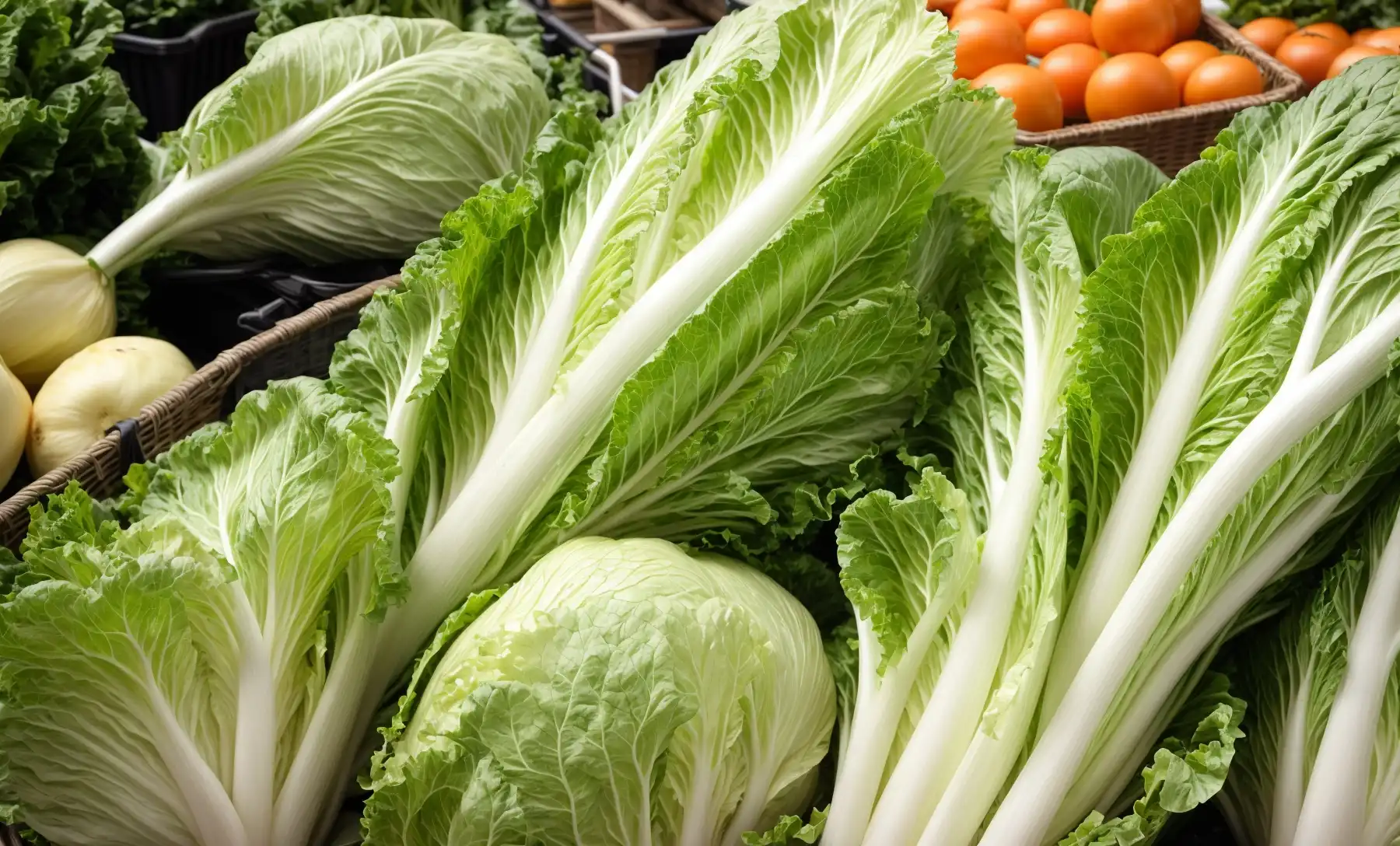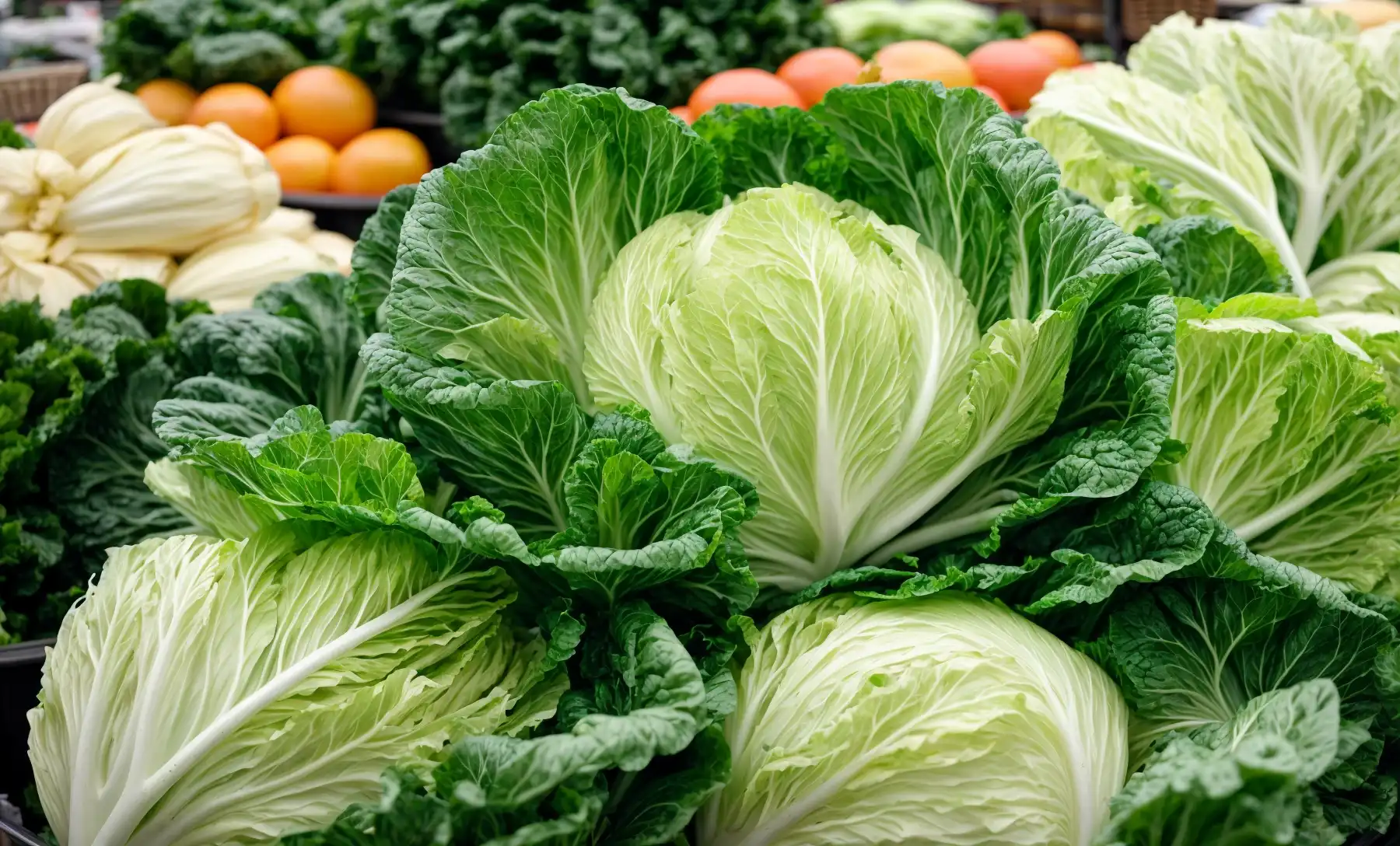Napa cabbage has a long, barrel-shaped profile with tightly packed, light-green to white crinkled leaves. Its appearance resembles a cross between romaine lettuce and pale Swiss chard.
Napa cabbage, often a staple in Asian cuisine, stands out in the produce aisle with its oblong shape and densely layered leaves. Known scientifically as Brassica rapa subsp. Pekinensis, it is a variant of the turnip and sports a milder taste than its peppery cabbage cousins.
Rich in vitamins and low in calories, Napa cabbage is a versatile ingredient favored for its sweet, crisp texture. It’s perfect for everything from crunchy salads to hearty stir-fries, and it’s a key component in the making of traditional Korean kimchi. Gardeners and chefs alike appreciate its relatively quick growth and the ability to add a fresh, delicate flavor to a myriad of dishes.
About Napa Cabbage
Napa cabbage, a staple in Asian cuisine, is becoming increasingly popular in kitchens worldwide. This vegetable is not just versatile in culinary uses but also rich in nutrients and easy to grow. Unlike its round cabbage cousins, napa cabbage boasts elongated heads and crinkled green leaves, offering a milder taste and delicate texture. Ideal for everything from crunchy salads to hearty stews, understanding what napa cabbage looks like and its attributes can enhance both your garden and your cuisine. Napa cabbage look like:

Defining Characteristics of Napa Cabbage
Napa cabbage, known scientifically as Brassica rapa subspecies pekinensis, is distinguished by its oblong shape and beautifully ruffled leaves. The leaves form a compact cluster that resembles a rosette at maturity. It’s the combination of soft, crinkly pale-green leaves with crisp, white stalks that differentiates it from other types of cabbage. The leaves are also known for their smooth surface and sturdy veins, which hold up well in cooking processes.
Origins and General Information
Believed to have originated in China many centuries ago, napa cabbage is a cornerstone of East Asian cuisine. It plays a central role in dishes such as kimchi, stir-fries, and dumplings. Given its historical roots, napa cabbage thrives in cool temperatures and can be found in various parts of the world, adapting to diverse growing conditions. From seed to harvest, it usually completes its growth cycle in 70 to 90 days, making it an ideal choice for gardeners who desire a bountiful and rapid yield.
Nutritional Profile at a Glance
| Nutrient | Value |
|---|---|
| Vitamin C | Rich Source |
| Vitamin K | Abundant |
| Folate | Significant |
| Dietary Fiber | High |
| Antioxidants | Contains Glucosinolates |
Napa cabbage is not just pleasing to the palate but also a powerhouse of nutrition. It is low in calories yet high in fiber, aiding in digestion and contributing to satiety. Moreover, its leaves are packed with vitamins and minerals such as vitamin C and K, which support the immune system and help in bone health. Additionally, the presence of glucosinolates, natural compounds found in cruciferous vegetables, offers potential health benefits by playing a role in cancer prevention.
Physical Appearance of Napa Cabbage
The Napa cabbage, a veggie marvel, isn’t just a nutritional powerhouse but also a feast for the eyes. Known for its distinctive characteristics in both form and texture, this leafy green stands out from its cabbage cousins. Let’s peel back the layers to reveal the visual treats that Napa cabbage has to offer.
Shape and Structure
Napa cabbage, also affectionately known as Chinese cabbage, presents itself with a shape reminiscent of an elongated football. Unique in its structure, it boasts firm yet pliable leaves that wrap tightly around each other, forming an oblong head. This compactness contributes to its subtle yet satisfying crunch, distinguishing it from the looser heads of other cabbage varieties.
Color and Texture Variations
Napa cabbage exhibits a captivating color palette, with its leaves transitioning from a pale green at the tips to a more creamy white towards the stem. This gradient not only adds visual interest but also hints at the cabbage’s tender texture. The outermost leaves are slightly more rugged, protecting the inner leaves, which reveal a softer and more succulent texture upon unfolding.
Size and Comparison With Other Cabbages
- Typically longer and less round than its round cabbage relatives.
- Size varies, with some heads reaching up to 18 inches in length and weighing about 1-3 pounds.
- Certainly larger than bok choy but smaller in comparison to a savoy cabbage.
Leaf Structure and Arrangement
The leafy attire of Napa cabbage consists of layers of juxtaposed leaves, each with a crinkled edge that adds texture. The leaves are attached to a central, firmer stalk, which also carries a crisp bite. This arrangement allows for the leaves to hold moisture, making them ideal for recipes requiring a delicate, sweet flavor and a crunchy texture without the toughness often associated with other cabbage types.
Culinary Uses of Napa Cabbage
Known for its signature crinkly leaves and a fresh, slightly peppery taste, Napa cabbage transcends culinary boundaries with its versatility. Often starring in a myriad of Asian dishes, this vegetable isn’t just limited to stir-fries and soups. Napa cabbage’s ability to retain a pleasant crunch or soften decadently when cooked, solidifies its role as a favored ingredient in kitchens around the world.
Popular Dishes Featuring Napa Cabbage
Here is a highlight reel of gastronomic creations showcasing napa cabbage:
- Kimchi: This iconic Korean fermented dish cannot be envisioned without Napa cabbage as its core ingredient.
- Baechu Doenjang Guk: A soul-warming Korean soybean paste soup frequently hugging chunks of Napa cabbage.
- Okonomiyaki: A savory Japanese pancake integrating Napa cabbage for a crisp, flavorful bite.
- Stir-fries: Various pan-Asian stir-fried dishes summon Napa cabbage for its texture and the way it absorbs sauces.
Raw Vs Cooked: Textural Changes
When served raw, Napa cabbage offers a juicy crunch reminiscent of an iceberg lettuce but with a layer of complexity. It’s an ideal base for salads or as a crunchy topping. Once cooked, it undergoes a delightful transformation—leaves wilt while stems retain a subtle crispness, creating a balanced texture that compliments a range of cooking methods from steaming to braising.
Pairing With Other Ingredients
Napa cabbage pairs seamlessly with a variety of ingredients. Its mild flavor acts as a canvas bringing harmony to the combined flavors:
| Ingredient Category | Pairing Examples |
|---|---|
| Proteins | Chicken, pork, tofu, seafood |
| Aromatics | Garlic, ginger, green onions |
| Vegetables | Carrots, mushrooms, bell peppers |
| Sauces | Soy sauce, oyster sauce, sesame oil |
Preservation Methods: Pickling and Fermentation
To extend the shelf life and add a tangy twist, Napa cabbage often stands as a prime candidate for pickling and fermentation. With high water content and a sturdy structure, it transforms into a tantalizing preserve. The cabbage is commonly sliced, salted, and then fermented to create probiotic-rich foods like kimchi. Alternatively, quick pickling can also infuse Napa cabbage with vinegary flavors, perfect for condiments or side dishes.
Know more: What Can I Plant Next to Cabbage
Growing and Harvesting Napa Cabbage
Napa cabbage, a variety of Chinese cabbage, brings a delightful combination of tender leaves and crisp stems to a multitude of dishes. The distinctiveness of this leafy green lies not just in its taste, but also in its appearance and growth pattern. Understanding the optimal conditions and appropriate techniques for growing and harvesting can lead to a bountiful, healthy crop. Below, explore how to cultivate your own Napa cabbage successfully, from sowing to harvest.
Optimal Growing Conditions
For a thriving Napa cabbage crop, specific conditions are essential. This cool-weather crop favors temperatures between 45°F and 75°F (7°C and 24°C). It requires a sunny spot, yet it’s also important to provide light shade in warmer climates to prevent bolting. Ideal pH levels for the soil range from 6.0 to 7.5, which is slightly acidic to neutral.
- Soil: Rich, well-draining soil packed with organic matter
- Water: Consistent moisture, around 1 to 1.5 inches per week
- Spacing: 15 to 18 inches apart to allow for full growth
The Lifecycle of Napa Cabbage
Napa cabbage’s lifecycle is a journey from seed to maturity split into several stages. Starting from seed germination, which takes around 7 days, the plant enters a vegetative growth phase, establishing itself over the course of 3 to 5 weeks. The head then begins to form, taking another few weeks to reach full size, which is a sign that it’s nearing readiness for harvest.
The key milestones in Napa cabbage’s lifecycle are:
- Seed germination
- Leaf development
- Head formation
- Maturity and harvest readiness
Harvesting Techniques and Timing
Timing the harvest is crucial to ensure the cabbage reaches its peak flavor and texture. Typically, Napa cabbage is ready for harvest 70 to 90 days after sowing when the heads are firm and dense. Cut the base with a sharp knife, leaving a few outer leaves to protect the head. Monitor your plants closely, as waiting too long can result in splitting, which could make the cabbage prone to disease and reduce its storage life.
Common Pests and Diseases
Napa cabbage, like many crops, is susceptible to pests and diseases. Aphids, cabbage worms, and flea beetles are common culprits that can damage the crop. To combat these, implement integrated pest management strategies such as using row covers, promoting beneficial insects, and applying organic pesticides when necessary. Diseases such as clubroot, black rot, and downy mildew also pose a threat to Napa cabbage. Regular crop rotation and proper spacing for airflow can help minimize these risks.
Preventive measures:
- Maintain proper spacing
- Encourage beneficial predators
- Apply organic pesticides judiciously
- Practice crop rotation
Conclusion
Napa cabbage, with its oblong shape and crinkly leaves, is a culinary staple in many dishes. Its pale green hues and crisp texture make it easily identifiable. Remember, this versatile vegetable adds a nutritious crunch to salads and stir-fries. Keep an eye out for it on your next grocery trip and enjoy its fresh, subtle flavor in your own kitchen creations.
Harvest more than just cabbages; reap a wealth of knowledge with Farm Pioneer. Our Cabbage section is a gardener’s treasure trove of tips and tricks.
